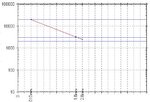T
treez
Guest

Hello,
On page 51 of the following (below) document concerning the ETD ferrite cores, the table in blue shows two values of the “AL” parameter. (“AL” corresponds to the ‘allowance’ of the ferrite core material).
One value appears to suggest that AL is 4000 when measured at 1KHz, and the other figure for AL is 5760, and suggets that this corresponds to 100KHz.
There is also a graph on page 51 which allows one to calculate the AL value corresponding to a particular core gap size. –however, this graph is quoted for measurement at 1KHz. –What is the point in having a graph for operation at 1KHz?……hardly anybody ever operates ferrite cores at anywhere near as low as 1KHz.
Also, does the AL value really vary that much with frequency?
E series document from TDK:
https://product.tdk.com/en/catalog/datasheets/ferrite_mz_sw_e_en.pdf
On page 51 of the following (below) document concerning the ETD ferrite cores, the table in blue shows two values of the “AL” parameter. (“AL” corresponds to the ‘allowance’ of the ferrite core material).
One value appears to suggest that AL is 4000 when measured at 1KHz, and the other figure for AL is 5760, and suggets that this corresponds to 100KHz.
There is also a graph on page 51 which allows one to calculate the AL value corresponding to a particular core gap size. –however, this graph is quoted for measurement at 1KHz. –What is the point in having a graph for operation at 1KHz?……hardly anybody ever operates ferrite cores at anywhere near as low as 1KHz.
Also, does the AL value really vary that much with frequency?
E series document from TDK:
https://product.tdk.com/en/catalog/datasheets/ferrite_mz_sw_e_en.pdf



